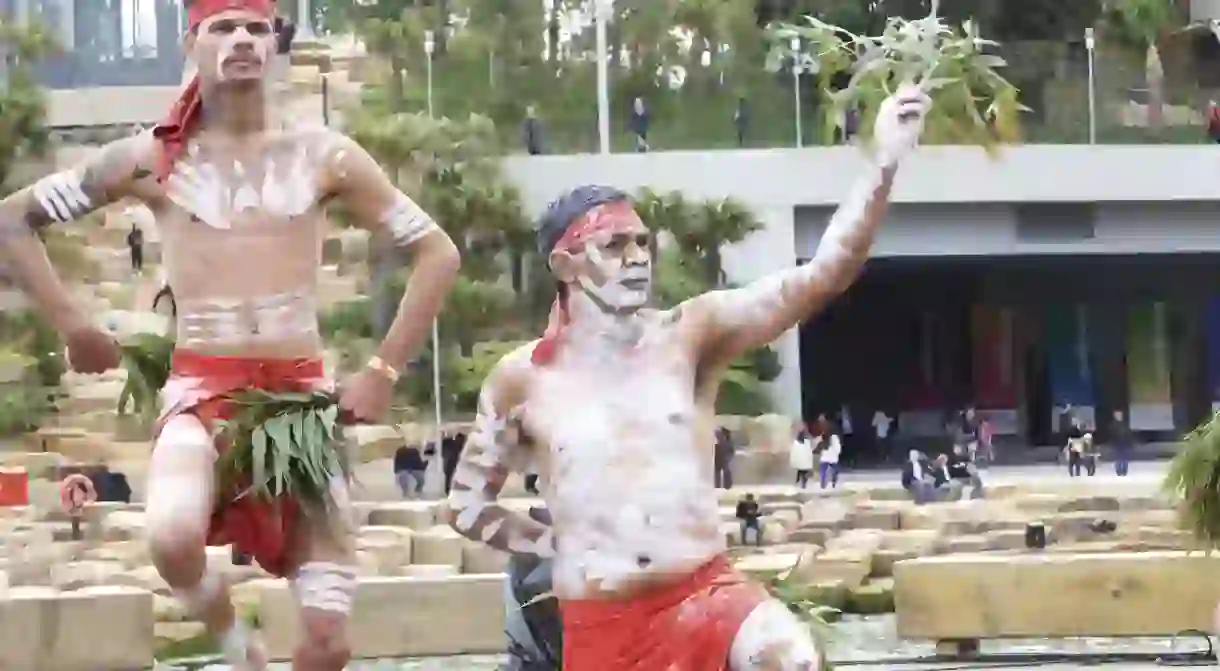11 Ways Indigenous Australian Culture Still Influences Society

Indigenous Australian culture dates back 60,000 years, but the world’s oldest surviving civilisation continues to play a vibrant role in modern Australian society. These are 11 ways Aboriginal and Torres Strait Islander people make an enormous contribution to life in Australia.
Language
Around 120-150 Indigenous languages remain in daily use today, and Aboriginal words aren’t confined to those diverse dialects. The broader Australian vernacular is loaded with hundreds of words from Aboriginal and Torres Strait Islander origins — particularly names for flora and fauna such as kangaroo, koala and billabong — not to mention the many more place names like Bondi and Canberra.

Sport
Aboriginal and Torres Strait Islander people are most visible in the sporting arena, particularly the football codes. Australian Rules footballers like Lance Franklin and Cyril Rioli and rugby league players such as Johnathan Thurston and Greg Inglis are only a handful of the Indigenous athletes that have made an immense contribution to Australian society. That’s not to mention world-renowned sportspeople like Patty Mills (basketball), Evonne Goolagong (tennis) and Lionel Rose (boxing).
Music
Music is another stage that provides Indigenous Australians a voice. Artists like Yothu Yindi, Jimmy Little, Archie Roach, Christine Anu and Troy Cassar-Daley have all helped blaze a trail that dozens of exciting young Indigenous musicians are following, including hip hop duo AB Original, up-and-comer Kuren, and indie singer Emily Wurramara.

Theatre
Cultural ceremonies are nothing new to the oldest surviving civilisation on the planet, but the performing arts are a more recent addition to Indigenous culture. The National Black Theatre became Australia’s first Aboriginal theatre company in 1972, growing out of the political struggles and land rights battles of the ’70s, while Melbourne’s Ilbijerri and Perth’s Yirra Yaakin continue the tradition today.
Art
Archaeologists have found ancient rock paintings that date back tens of thousands of years — artworks that were used to convey Indigenous cultural stories — and Aboriginal art is a cherished feature of most Australian art galleries in the new millennium. Celebrated watercolour artist Albert Namatjira is the country’s most recognised Indigenous artist, while schoolteacher Geoffrey Bardon helped expose white Australians to Aboriginal art in the 1970s and ’80s.

Literature
There’s no shortage of Indigenous writers who have made huge contributions to Australian society. Poet Oodgeroo Noonuccal was the first Aboriginal Australian to publish a book of verse (We Are Going in 1964) as well as a powerful campaigner for land rights, Kevin Gilbert is an iconic Indigenous activist, and award-winning novelists Kim Scott and Alexis Wright carry that literary tradition into the 21st century.
Tourism
Indigenous culture is one of Australia’s biggest drawcards for international visitors. The continent is peppered with natural features that are considered sacred by Indigenous communities, and they can usually be explored with an Indigenous guide — Uluru and Kata Tjuta in the Red Centre, Kakadu or Arnhem Land in the Top End, the Flinders Ranges in South Australia, the Pinnacles desert in Western Australia and the Blue Mountains west of Sydney are all good examples.

Politics
Australia’s parliament is hardly replete with Aboriginal faces and the current government is none too popular, but there are more Indigenous voices in the halls of Canberra than there’s ever been before. Labor’s Linda Burney became the first female Indigenous MP in 2016, joining the first male MP Ken Wyatt (Liberal), with Labor senators Malarndirri McCarthy and Pat Dodson sitting in the Upper House, all doing their best to keep Indigenous issues on the political agenda.
Television
Mainstream television has similar issues with racial diversity, but more Indigenous faces are slowly appearing on Australian TV screens. Journalists Stan Grant and Ray Martin, actors Deborah Mailman and Miranda Tapsell, programs like Black Comedy and Cleverman, and the dedicated NITV channel help project Indigenous voices into Australian living rooms.

Education
Australia’s national school curriculum ensures that all Aussie kids learn about the 60,000 years of Indigenous culture that preceded European colonisation, and understand the richness and diversity of modern Aboriginal and Torres Strait Islander communities. Indigenous studies courses also play a large role on the university campuses of Australia.
NAIDOC Week
Indigenous issues take centre stage in the public conversation during National Aboriginal and Islander Day Observance Committee (NAIDOC) Week, held in the first week of July every year since 1975. Schools, councils and workplaces embrace activities that expose non-Aboriginal Australians to Indigenous culture, including public displays in all major cities and towns.













